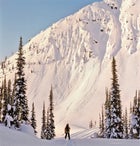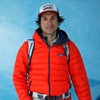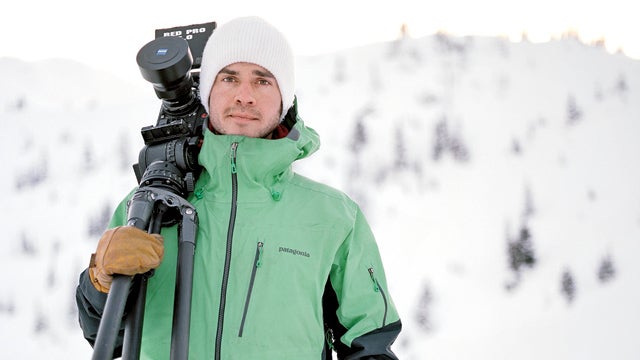I’M DOZING IN a hammock slung between two snow-ghost spruces overlooking a gypsy-camp movie set put together by . A dozen or so locals, professional skiers, and hangers-on, all dressed in vintage drover coats, animal skins, and thrift-store fishing sweaters, are walking around on hobbit paths that wind through the woods. We’re a few hundred yards off the back side of the White-water ski area in Nelson, British Columbia, in a clearing decorated with a tepee, an igloo, several blue-tarped lean-tos, and a couple of four-season tents disguised under khaki-colored canvas. Watching the actors and crew move about, I can’t quite tell who’s in character and who’s for real.
Behind the Scenes with Sweetgrass Productions
Director Nick Wagoneer discusses the making of the new Sweetgrass movie, Valhalla, and “the best, biggest ski action we’ve ever filmed.” From left: Mike Brown, Waggoner, and Ramras in Nelson, B.C.
From left: Mike Brown, Waggoner, and Ramras in Nelson, B.C.
A few feet away, Cody Barnhill, a 30-year-old professional freeskier from Alaska, is disrobing and locking limbs with his girlfriend, Meredith Richardson, a 27-year-old reporter for . Santa Barbara–based photographer Lindsey Ross snaps a picture. Ross, 33, has schlepped in an Ansel Adams–style 8×10 box camera and a portable darkroom, and has been shooting collodion wet-plate nudes of just about everyone here.
Down below Barnhill and Richardson, a guy named Todd, a midforties snowboarder with thick dreads and a gentle voice, is in a similar state of undress with an early-twenties local named Beth. It’s early March, and they’re scrubbing themselves with handfuls of snow, the possible goal of which is backcountry hygiene. As they wince from the cold, Sweetgrass codirectors Nick Waggoner and Ben Sturgulewski, both 27, film the act in high definition, offering occasional directorial comments. I knew there would be nudity—one of Waggoner’s ex-girlfriends had said to me, “I hope you’re ready to get naked”—so none of this is too surprising.
“Having naked people skiing is really about expression and finding comfort with your own self,” Waggoner, the outfit’s figurehead, explains. “This is not a negative thing.”
The Sweetgrass crew, whose base of operations this winter is a three-story, five-bedroom house on the south side of Nelson, spent much of the previous night around a towering bonfire, filming scenes for their upcoming release, . An art-house take on your typical ski film, it will tentatively feature something exceedingly rare in the genre: a narrative arc. The movie is a mostly fictional account of a young American paper pusher named Conrad, played by Barnhill, who burns out, quits his job, and heads north in his Volkswagen Beetle to reclaim the youth he lost to conventional ambitions.
Along the way, Conrad meets a tribe of feral skiers, including Ayla, played by 24-year-old professional skier Sierra Quitiquit, and the cultish Rasheek, played by Alex Monot, a lanky, bearded, 38-year-old Frenchman who looks like the sixth wizard of Middle Earth and barely knows how to ski. They’re all searching for something that Waggoner calls the “eyes of youth,” a theme prominently featured in a trailer Sweetgrass released in December 2012, along with lots of swirling visuals, fire dancing, Sturgulewski’s rear end, and skiers soaring gracefully off impossibly high cliffs. “When I think of freedom, it’s that first snowfall and walking out into it,” says Sturgulewski.
Valhalla, which debuts September 13 at the Paramount Theater in Denver, is inspired by Woodstock and the sixties—or, rather, by Waggoner and Sturgulewski’s interpretation of that era. They started shooting two years ago here in Nelson. Tracking the annual migration of professional skiers, photographers, and filmmakers, they moved their operation to Alaska for a few months in the spring of 2012, only to return to Nelson again for the winter of 2013. The whole process is less about efficient storyboarding and more about curating the enviable lifestyle they want to portray on film—the ultimate freewheeling ski-bum existence. And, in a way, the finished movie is only part of the performance art. But it’s a big part, one that Patagonia, Dynafit, and a dozen other upstanding ski-industry companies have ponied up real money to see produced.
Right now there isn’t much skiing going on, though. After one of the snowiest Decembers in B.C. history, blizzards have given way to rain crust, and the crew hasn’t touched powder in weeks. This morning, Sturgulewski and Waggoner are spitballing ways to effectively use Quitiquit, their female lead. A self-identified “ironic vegan” who occasionally eats meat, she’s also appearing in the forthcoming Warren Miller film Ticket to Ride and has been working as a fashion model for apparel company American Eagle.
“We could shoot the nude drop-in,” says Sturgulewski, referencing one of several naked ski-action segments in the film.
“Or we could have her interacting with animals,” offers Waggoner.
I FIRST MET Waggoner in 2008, during his senior year at Colorado College. He took a journalism class taught by ���ϳԹ��� editor-at-large Randy Wayne White, who brought his students to Santa Fe to meet editors and photographers. Waggoner, who grew up in New York City’s Greenwich Village and attended the tony Upper East Side Loyola School, stood out as having both the talent and the ability to sell himself at a young age.
His self-assignment for the class was to write a story about the reinvention and massive expansion of British Columbia’s Revelstoke Mountain Resort. But he had other motives. “I convinced the PR guys at Revelstoke to comp my heli time,” says Waggoner, who sought out the best local skiers to shoot for a film. During a spring break, on a press junket partially paid for by Colorado College and partially by Revelstoke, Waggoner captured the first scenes of what would become , the film he made with freshman roommate Sturgulewski, classmate Zac Ramras, and Mike Brown, a childhood friend of Ramras’s from Salt Lake City. The four would later name their fledgling production outfit Sweetgrass, which is headquartered in an old school bus that’s most often in Colorado.
If you’re aware of the quartet, it’s likely because of their second film, , which chronicled the 2008–09 winter they spent in Hokkaido, Japan, among a soulful group of local snowboarders and artists. That movie contains what’s easily the best four minutes and four seconds in ski porn: a mesmerizing montage of neck-deep powder turns through silver birch trees set to Bon Iver’s “Skinny Love,” released six months before anybody had ever heard of Bon Iver.
Waggoner and company have a rare ability to boil skiing down to a feeling. “What strikes me most about Sweetgrass’s work is the subtlety of the art,” says legendary ski-film director Greg Stump. “The images are stunning. The skiing is great. The use of light is pretty dang perfect. And then they top it off with musical choices that are downright haunting.” The marquee scenes in many ski films—a lone figure on an Alaskan ridge about to drop in on a seemingly endless, obstacle-ridden, near vertical apron of snow—are almost always shot from helicopters. Sweetgrass, which occasionally uses helicopters to get around, never films from them. Its productions are quieter; watching one makes you want to quit your job and go on an extended quest for deep powder.
Which is exactly what the Sweetgrass crew embarked on when making their wildly ambitious third film, 2011’s , a western-themed ski movie set in the Andes and featuring narration adapted from Joseph Conrad’s . As if the conceit wasn’t highfalutin enough, they decided to translate the text into Spanish and then subtitle it back into English on-screen.
The film was hampered by several major problems, including a lack of good snow, unreliable vehicles and lodging, and the skiing deaths of two of their athletes. “Solitaire wasn’t my favorite movie,” Waggoner says. “It was stressful and impossible to shoot.”
Valhalla will be different but no less risky as an artistic endeavor. Waggoner and Sturgulewski started with a 60-page script, but the finished product will have almost no dialogue. It will be narrated mainly by Barnhill, Quitiquit, and Monot in a series of moody voice-overs—the sort of thing that can be either unforgettable or cringe inducing.
Waggoner understands the challenges of structuring a film this way, but he might well pull it off. He’s become one of the most respected filmmakers in the genre, and he isn’t under serious financial pressure as he pursues his vision. Although ticket and DVD sales matter to some extent in a production like this, his primary obligation is to make a film that his sponsors will want to help publicize. And for the first time, he has his pick of the world’s best freeskiers, including Barnhill, Oregon native and freeskiing elder statesman Pep Fujas, and high-flying Canadians Kye Petersen and Eric Hjorleifson.
Sweetgrass has nicer toys these days, too: the crew is shooting with a pair of $40,000 Red cinema cameras. (They had to sell a third one to make rent.) “We don’t want to be Brain Farm,” says Waggoner, referring to the Jackson Hole–based production house with the most expensive moviemaking equipment. Whereas Brain Farm is the Michael Bay of the industry, Sweetgrass aspires to be its Terrence Malick.
WAGGONER HAS a kind of soft-spoken, charismatic innocence. And he often dresses like a dandy, favoring shawl-collared sweaters and fringed suede jackets from thrift shops. Combined with his well-stamped passport, it makes for a conspicuous profile, as I learned when I crossed the border on my way to Nelson.
At the international checkpoint north of Spokane, Washington, an inspector in the secondary screening area asked to see my phone. While he searched it, his colleague explained that cell-phone data helped “reveal peoples’ true intentions.”
“How do you know Nick?” the inspector asked when he returned.
At that point, Waggoner’s name was not in my contact list, but there was a text message from his cell-phone number giving me his address in Nelson, which is commonly referred to as the country’s pot capital. Waggoner has been flagged in Canada’s database since 2010, when agents detained him for 11 hours and strip-searched him. “Where are the drugs, Nicholas?” they wanted to know.
He didn’t have any. Like most of the rotating cast of 15 people who are currently inhabiting the Sweetgrass mansion, Waggoner practices yoga every day and prefers the town’s health-food co-ops to its famous smoke shops. (He does have a weak spot for ten-year Laphroaig Scotch, though.)
At the moment, the house’s other residents include Barnhill; the Frenchman Monot; Quitiquit; her boyfriend, professional freeskier Julian Carr; the photographer Ross; and a few others. In what should be the dining room, camera gear and beat-up tripods litter the floor like kids’ toys. Quarters are tight: Barnhill is currently sleeping in a closet under the stairs. But everyone mostly likes the arrangement. Mostly. On a pizza box in Waggoner’s room, I find a note Ross wrote to Waggoner with a Sharpie, lamenting her inability to sleep with all the loud sex that’s happening but not involving her.
Over the course of the week, all four of the Sweetgrass guys are in constant motion. Brown makes several six-hour round-trips to Spokane to shuttle talent to and from the airport. Ramras picks up a truckload of fireworks for a night-skiing shoot, and Waggoner rents a generator for another, even bigger bonfire party they hope to film at Whitewater Ski Resort.
Occasionally we ski. On one of the few runs we take during the week, Barnhill, who is arguably the most underrated freeskier in America, drops the group while skiing backward down a steep tree-studded glade of icy moguls. And somehow he manages to look like he’s having fun while doing it.
One day, we drive a minivan an hour north to an abandoned mine, where a dozen defunct Into the Wild–style buses sit collecting snow. The goal is to shoot scenes of Quitiquit as the jackbooted, union-suit-wearing Ayla squatting at an abandoned cabin, trying to carve a living out of the land. Only things don’t go as planned. Waggoner shoots a few scenes of Ayla catching a trout and laying out her bedroll, but then the minivan won’t start. While Ramras tries to revive the vehicle, we decide to cook up one of the props—the store-bought fish Ayla supposedly caught on a fly. We fry it on an iron skillet over an open fire, throw in some leftover curry someone brought along, and stand around scooping it into our mouths with bare hands. Waggoner produces a couple of cans of cold beer, and for a moment life imitates art. Then Ramras coaxes the van back to life.
Toward the end of the week, everything is finally set for the bonfire party. The resort’s management is so enthusiastic about hosting it that they have their ski patrollers saw up and stack more than a cord of eight-foot logs to fuel it. At the appointed time, a mix of locals and cast members stage a hippy gala set piece in the woods, with dancing, flaming Hula-Hoops, and generator-amplified music. The inferno is massive. It looks as if a small house is on fire.
Sturgulewski and Waggoner spend much of the night filming Monot’s Rasheek leading Barnhill/Conrad into the circle of gyrating bodies, which includes the mysterious Ayla, and delivering one of the film’s few lines of dialogue: “C’mon, man, let’s get some love.”
Waggoner says the sponsors have been accommodating to Sweetgrass’s style of production. They haven’t required him to turn in anything more than the trailer, which they’ve already posted online. Do they know just how free-spirited the film will be? He doesn’t want to ruin the surprise.
When pressed, he says, “We’re not going to show a cut of it to our sponsors ahead of time. At some point, you just have to say fuck it.”
is a senior editor at ���ϳԹ���.


